What to wear to Oktoberfest Munich 2024: a top guide
Planning a beer-infused trip to the Bavarian capital and wondering what to wear to Oktoberfest, Munich in 2024?
Wondering what the heck a dirndl is and how to wear lederhosen before you hit up your new favourite beer tents?
Or maybe you’re wondering which shops to hit up to buy your perfect traditional outfit?
Do you have to dress up or can you just attend in your normal clothes? Will you get told off for wearing your favourite pair of sneakers?
I’ve got everything you need to know about traditional Bavarian attire and comfy shoes coming right up, grab your steins and flower crowns and let’s hit it!
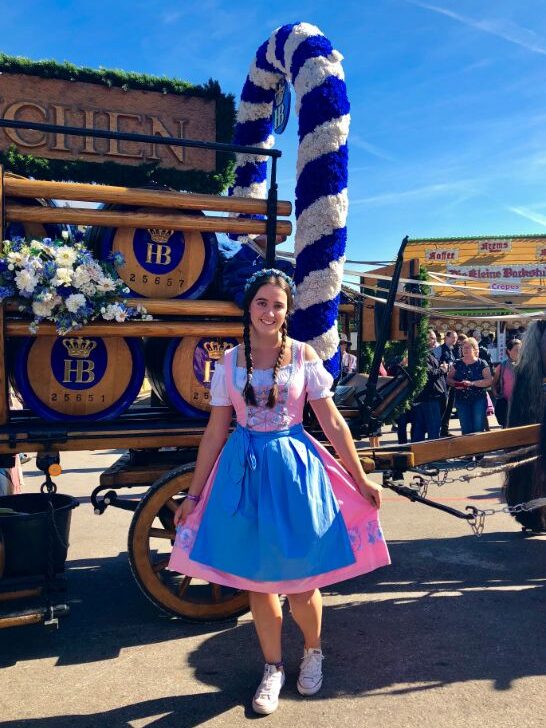

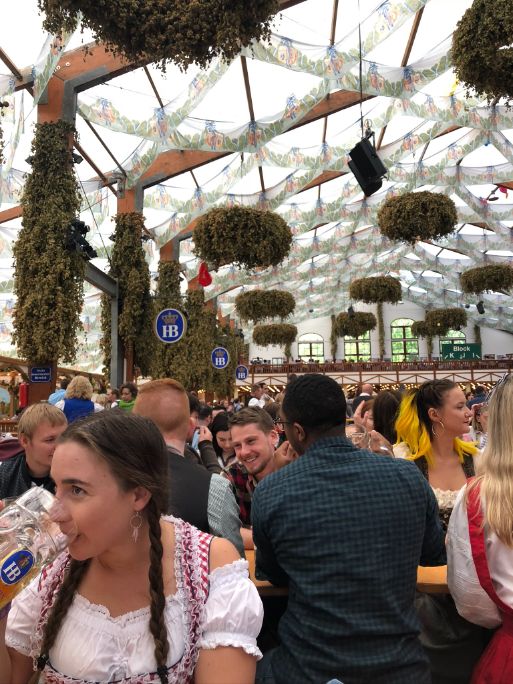
A quick rundown on Bavarian local culture and Oktoberfest itself
Oktoberfest, AKA the world’s largest beer festival, runs for roughly two weeks from late September through to early October.
Giant beer tents fuelled by local breweries and carnival rides fill the enormous space of the Theresienweise, attracting 5 to 7 million visitors a year.
Who drink upwards of 5 million litres of beer over the course of the festival, with plenty of roasted chickens served to help soak up all of the beer.
And giant pretzels naturally.
The best times to visit are during the week as weekends are absolute peak hour in the beer tents, come Monday to Friday if possible and enjoy a less crowded experience.
And you won’t need to get up at the crack of dawn in order to nab a seat at a table, though sharing with strangers is encouraged.
Don’t worry about buying expensive and hotly contested table reservations unless you’re attending with a massive group, a couple or a few friends will easily be able to find a space if you come around 11am. Unlike the line-up you’d likely be joining to get a seat on the weekends.
If the weather is nice, then the large beer gardens outside the tents will also be a great shout and less crowded than inside.
Note: If you know that you’re attending Oktoberfest, try to book your accommodation as early as possible in order to get the best price. Hotel rates tend to rapidly rise as the Wiesn gets closer, especially those that are walking distance to the grounds.
If you need to book last minute, you might have luck finding more reasonably priced rooms in the outer suburbs or villages surrounding Munich.
For more info, I’ve got the complete guide on where to stay for Oktoberfest just for you!
Bavaria is actually much older than Germany as a nation, Bavaria used to be a kingdom right up until 1918. The Bavarians themselves are rightfully very proud of their long history and will often state that they’re Bavarian instead of German, which I always think is quite cute.
From traditional food like Obatzda and Weisswurst to oompah music, the local cultural traditions are still widely practiced and I love getting to join in whenever I’m visiting Bayern.
This is also why staying away from the “Halloween” style costumes and sticking to proper “Trachten” outfits is looked upon more favourably by the locals, it’s seen as a sign of respect to their traditions.
Don’t get me wrong, there will still be people attending in some questionable outfits but you won’t be one of them because you’re taking the time to read this guide!
Plus, you’ll look great in all the photos and who doesn’t want that!
What should ladies wear to Oktoberfest Munich?
Traditionally, the word Dirndl – which refers to the brightly coloured and patterned dresses – referred to an Austrian maid’s outfit that was made popular by Bavarian nobility, a fashion that caught on. This style of the traditional dress was made to reach to roughly ankle length.
They became the go to outfit for special occasions like weddings, some ladies still choose to get married in traditional dirndls today.
You might spot them being worn by waitresses in local restaurants, especially ones that serve up Bavarian cuisine and waitstaff in traditional attire.
Intricately sewn with colourful fabrics and delicately laced corsets, they’re designed to slim the waist and enhance the bust.
The whole outfit is made up of a dirndl which reaches to at least the knees, a schurze or apron tied over the top and a small half blouse that covers the upper arm and completes the outfit.
Initially, they only existed with long skirts but you can get different lengths that range from ankle through to slightly above the knee.
Shop staff will be quick to tell you that the knee is the limit for a short dirndl if you’re trying them on in store in Germany.
The long dirndls are usually the most popular with older women but go with whatever you feel most comfortable in.
The costume style mini skirt is a sure-fire bet that you’re not about to purchase a dress that Oma (German grandma) will approve of, so keep that in mind!
Most commonly, shops will sell a combination of the dirndl, apron and white blouse for a special price, the shops that appear at Oktoberfest time specialise in selling the whole ensemble ready for you to purchase.
You’ll find that usually, the dirndl and apron are made to match each other and you can chop and change the dirndl blouse that you like the best.
There are different bust coverage options depending on what you’re comfortable with, often with ruching that you can adjust to your liking.
The shop assistant might even recommend a push up bra to go with your dirndl, while this might seem a bit weird, they’re just attempting to get you the “perfect” Oktoberfest look.
This may or may not align with what you think is the perfect look so feel free to decline the kind offers of advice!
What does the apron bow on a dirndl mean?
At Oktoberfest, your apron bow has an important secret meaning that you will want to know. Though the other members of your table could be too merry to notice.
The position that you tie your apron knot in signifies your relationship status according to long-held traditions.
– Tied on the left side indicates that you’re single and ready to mingle
– Tied on the right side means that you’re married or in a relationship – AKA spoken for
– Tied in the middle means that you’re a child
– Tied at the back means that you’re a widow or staff, depending on the situation
These aren’t any hard and fast rules, more of a playful guide and I’m not convinced that many people take much notice anyway.
You might need to utilise more than just your apron knot to inform people that you’re not on the market if you have persistent admirers.
Safety notice: If you find that someone is making you feel uncomfortable or worse, you should alert your server who has a direct line to security. Who will come right over and sort it out for you.
All the staff are there to help you feel safe so don’t be afraid to speak up if you need assistance. There are also large first aid, women’s safety and police tents on site if you need help beyond security.
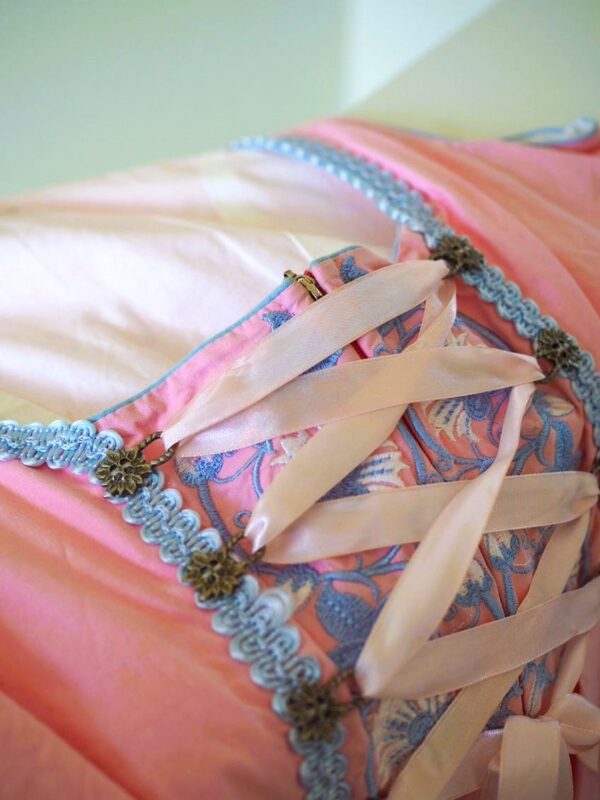
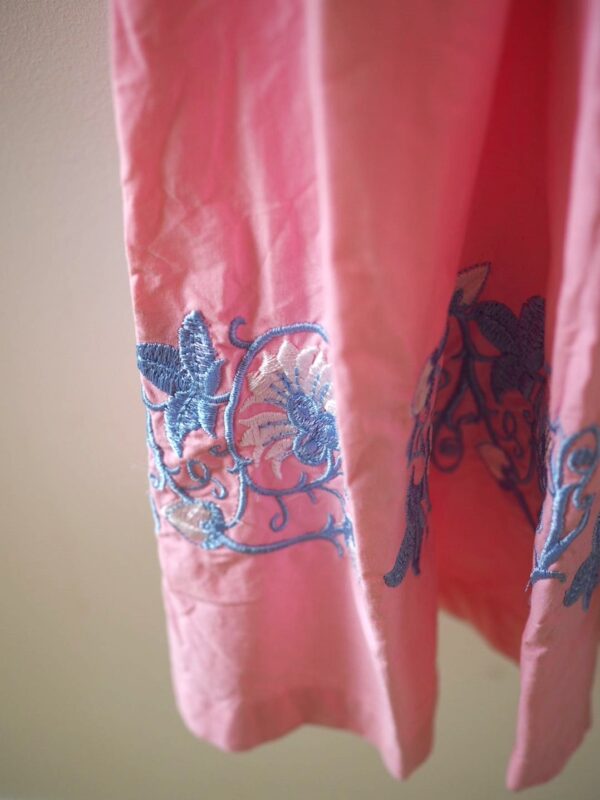
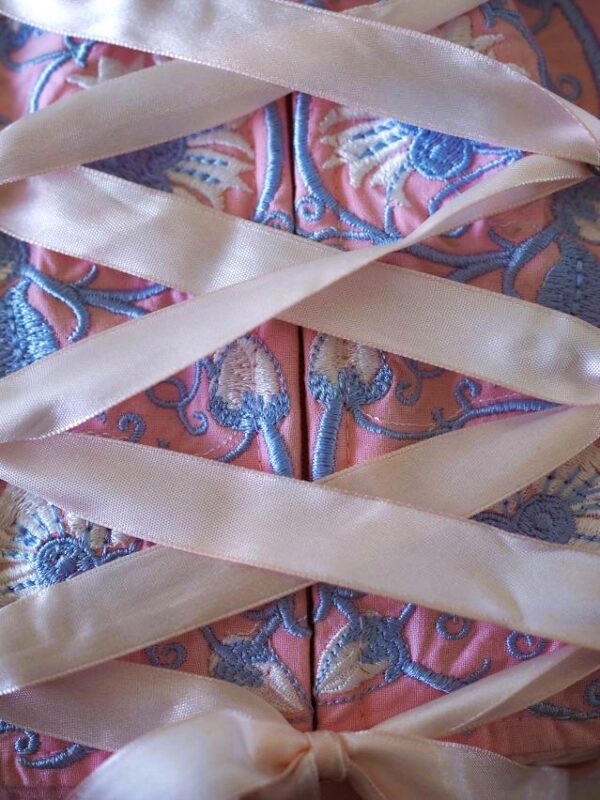
Lederhosen for ladies – Ladyhosen!
If you’d prefer not to wear a dirndl, you could opt for a pair of lederhosen – there are styles made specifically for ladies sold all around Munich and Germany. These come in option with braces (the sections that pass over your shoulders to hold the shorts up) or with just the thick shorts.
And usually some variety of checked or white shirt to go with the shorts, often embroidered with vine and flower patterns.
Be sure to double check how the shorts feel when sitting down, the thicker material may rumple and pinch depending on the fit and you could be spending a big portion of the day sitting!
Shop assistants will be able to provide expert advice on the different fits and options that will give you a comfortable outfit for the big shindig.
While you’re wandering around the city centre of Munich, check out this self-guided walking tour!
What should men wear to Oktoberfest Munich?
For the gentlemen, we’ve reached the section of this guide where I get to spend plenty of time writing about leather breeches. It’s lederhosen time!
These sturdy, thick trousers were originally designed to be hard-wearing work trousers for peasants working out in the fields, not for fancy occasions.
Eventually though, they came through as a cultural icon and symbol of Germany, especially down south.
Oktoberfest possibly has a large part to play in this resurgence when they declared that dirndls and lederhosen would be the official dress code of the celebrations in the 1800s.
There were even efforts made by kings going on visits out to different villages to wear some very fancy lederhosen to show their support for the traditional culture.
Lederhosen and dirndls are also popular in Austria, some villages are even famous for wearing them in their everyday life – Bad Aussee being one.
There’s a few different components to the official old-school lederhosen outfit:
Lederhosen refers to the shorts in an above the knee style, Bundhosen refers to those that fall slightly below the knee. There are even long Lederhosen that fall to the ankle as an option for colder days, though I don’t think I saw anyone wearing them at Oktoberfest.
They can be made out of a variety of different types of the leather, buckskin is the most popular due to its softness. They also come in synthetic versions to cater for those who don’t want to wear leather with options in shades of brown and cream, as well as more brightly coloured versions.
The buttons are traditionally made from antlers but cheaper versions will just use normal buttons.
The braces or suspenders go over your shoulder to hold up the shorts, adjustable for your comfort, should match your lederhosen and are also made of leather.
They attach to your shorts via the buttons and can come in either a H or a V style, often with a small, decorated chestplate holding them together.
Traditionally, a white, long-sleeved shirt is worn with Lederhose but you will also see different checkered shirts sold as part of the sets.
Colours are usually red, blue and green checks, you can easily bring your own shirt with you if you’d prefer to just purchase the shorts when you’re in Munich. Short sleeved shirts are considered untraditional but you can roll the sleeves up on your long sleeved shirt if it’s hot.
Top tip: Like I said above, things can get messy in the tents so if you’re sticking to a budget for this trip, just bring an old shirt from home, it’ll probably get covered in beer regardless.
Both the above knee and over the knee versions are worn with calf socks to finish off the outfit, either white or beige with cable patterns and often a coloured top.
The Loferl are more similar to calf warmers rather than socks, worn only over the largest part of the calf and skin must be visible below them.
I know, I know, I don’t make the rules in Bayern, I’m just writing about them.
These adorable calf warmers are worn with no show socks these days and are usually sold with matching little socks when purchased, this is the super traditional route when it comes to wearing proper Tracht.
If you decide to go for the Loferl calf warmers rather than white ankle socks, you will get odd looks if you wear anything other than the Haferl shoes that are meant to go with them.
Though I haven’t worn chunky leather shorts myself, I’d say from seeing what others were wearing at Oktoberfest, the above the knee style Lederhosen are more popular and probably more comfortable when sitting down for a long time!
If you’re heading into a physical store in Munich, you’ll be able to test that out for yourself to decide which style you prefer.
The white or checked shirt is a matter of personal preference as well, you can absolutely bring along a suitable shirt with you if you’d like to just buy the lederhosen.
I’ve also seen plenty of people go for long white socks rather than hand over extra dollars for the fancier socks.
What kind of accessories should you wear to Oktoberfest?
There are a few different options for accessorising your perfect Oktoberfest outfits, braids and flower crown headbands are super popular amongst the ladies.
Bonus points if you can find flowers that tie into the colour scheme of your dirndl.
You will likely find some options for sale as you wander around the city but you can always bring some with you if you feel like being very organised.
There are also lots of jewellery designs with “alpine” themes including Edelweiss flowers, many of the charms are designed to be worn as a choker style necklace on a piece of ribbon but you can easily swap this for a chain. Or wear your regular jewellery if you’d prefer.
Just remember that you may end up spending the whole day in a beer tent getting very merry so perhaps not the event to bring Grandma’s heirlooms to.
Take a look at the official Oktoberfest website for some tips on hairstyles and style to match your perfect dirndl.
Another option is an alpine hat or Tirolerhut, an option for all, these are traditionally made of felt and accented with a feather in the hat band.
You’ll probably see them in different earthy tones like green and grey, an authentic one will not be cheap though!
What kind of shoes should you wear to Oktoberfest Munich?
The final piece of your beautiful Oktoberfest outfit, what to wear on your feet!
A lot of the younger Germans are going with that trusty piece of footwear we all know and love, the humble white tennis shoe. So don’t be worried if you’re like me and bring only all-rounder shoes with you on holidays, you won’t look out of place.
Technically, the only shoe that you’re “allowed” to wear with a dirndl traditionally would be a black low heel.
Ankle boots, loafers and ballet flats are common sights at Oktoberfest paired with a dirndl.
Just make sure to bring or buy comfortable shoes, the festival grounds are MASSIVE and it’s a hike from one end to the other.
Which won’t be much fun if your feet are protesting about wearing high heels.
Bonus if they have grip, the surfaces in the tents can get slippery with all the spilled beer, which is just a given as the night wears on at the Wiesn.
Haferl shoes are traditionally worn with lederhosen for the gentlemen, formerly work shoes, they come with a thick sole and are laced at the side.
Usually made from leather, you could easily substitute them for any regular dress shoes unless you’re planning to enter into a best dressed competition.
I spotted plenty of young locals wearing white tennis shoes and lederhosen and for the older guys, regular lace up shoes or loafers.
Wearing running shoes with lederhosen might raise some eyebrows but you do you.
There’s plenty of other wild stuff happening at the Oktoberfest celebrations like drunk people getting carried out of the tents to attract the locals attention.
Check out the ultimate guide to Oktoberfest so you can do the Wiesn like a pro
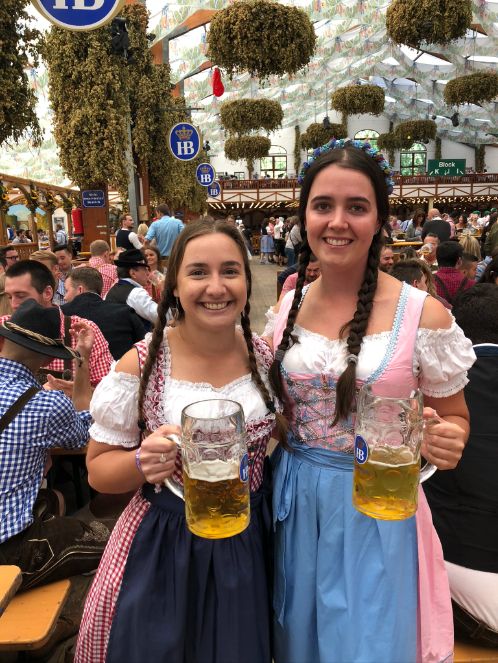
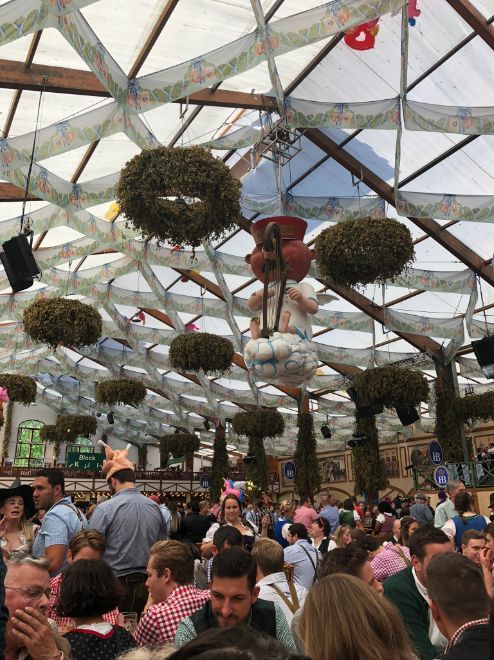
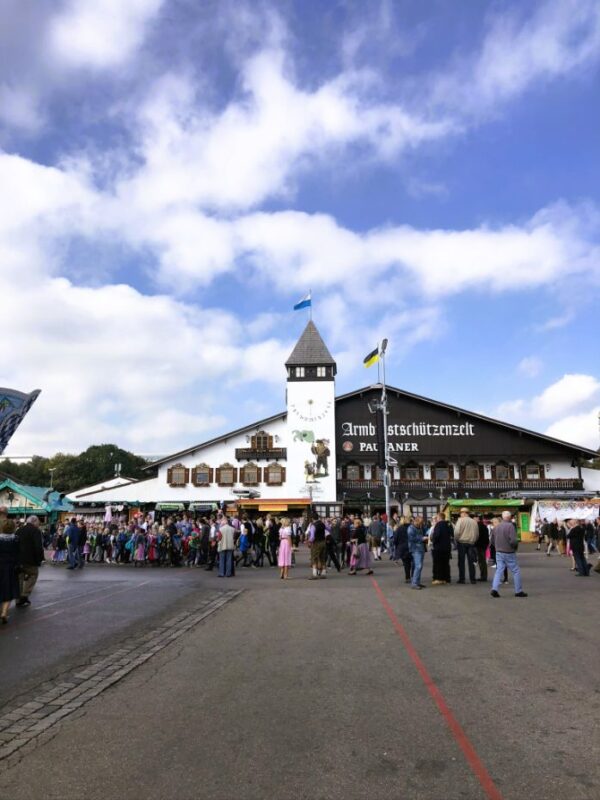
What should you not wear to Oktoberfest?
There are only a few things that you should avoid at all costs:
The super tacky “Halloween” Oktoberfest costumes – these will definitely earn you side eye from the locals and you could always wear your regular clothes instead, you’ll probably be a lot more comfortable!
The beer tents often finish up with everyone dancing on the tables and this might be uncomfortable wearing a micro Halloween outfit.
Plus, there is actually a dress code for the tents and people can be refused entry for inappropriate clothing so just stick to something that you’ll be comfy in!
We could chat about what shoes are best to go with traditional lederhosen and dirndls until the cows come home.
But the main non negotiable is to wear closed toed shoes!
I care deeply about the welfare of your toes and sandals, thongs (to Aussie readers) or flip flops will not protect you from the aggressive stomping of your neighbours in the beer tents.
Where can you buy a dirndl and lederhosen in Munich?
So where should you go to buy your perfect dirndl? When it’s Wiesn time, little shops and stalls with dirndls and lederhosen pop up all over the city.
We’re talking all over the main train station and that was a huge win for me when I decided that I needed a flower crown to complete my outfit!
Aside from the pop up stalls, I’ve got a little list of places around the city centre where you can nab a pretty dirndl or a crisp set of Lederhose.
Lederhosen & Dirndl Outlet Shop München: Pop up store across from the main train station, relatively cheap prices, you might spy the same dirndl on someone else when you’re in the grounds but the price reflects that.
Inntaler Trachtenwelt München: Pop up store located just over the road from the Oktoberfest meadow, a more limited range than their larger store but still plenty to look through and find your favourite.
Almwelt: Over in the city centre, this store has oodles to choose from and more high end designs, expect to pay a bit more here for a well-crafted dirndl.
Lederhosen Trachten & Dirndlverleih: A rental store for high quality outfits literally around the corner from Oktoberfest where you can rent out the outfit for the amount of time that you need them. Make a reservation before you arrive in Munich and you only pay when you pick up the outfit, plus the cleaning fee is included!
C & A: A large department store with some dirndl options, worth a look if you’re on a budget! They also have an online shop for you to peruse the styles when it’s the right time of year.
I’d advise coming to grab your outfit the day before you’re planning to go to Oktoberfest so you’re not running around stress shopping and heading to the beer tents with the tags still attached.
Top Tip: You can also keep an eye out for second hand dirndls on the standard clothing resale platforms near you but personally, I liked having the variety to choose from in store.
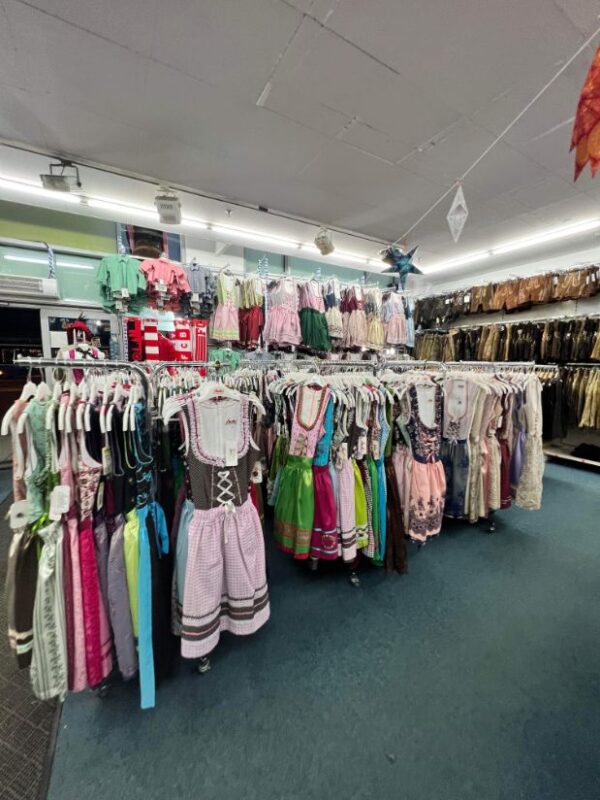
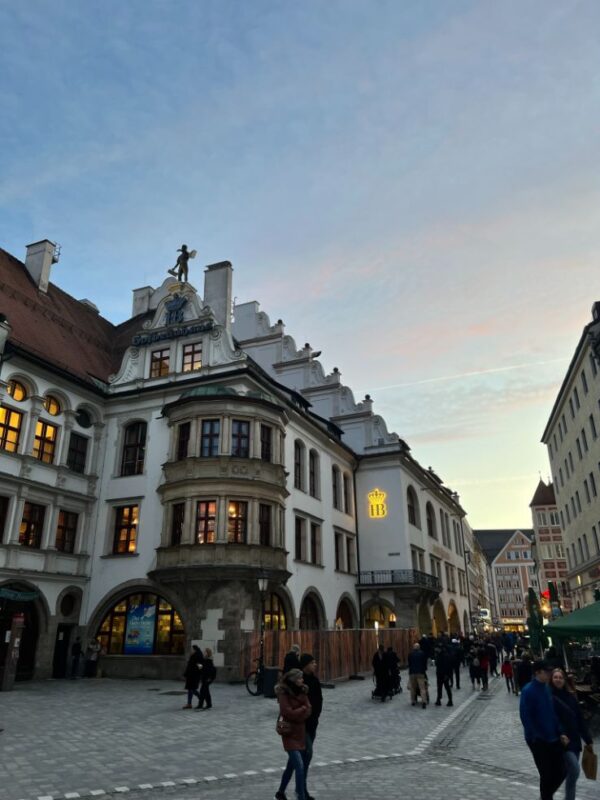
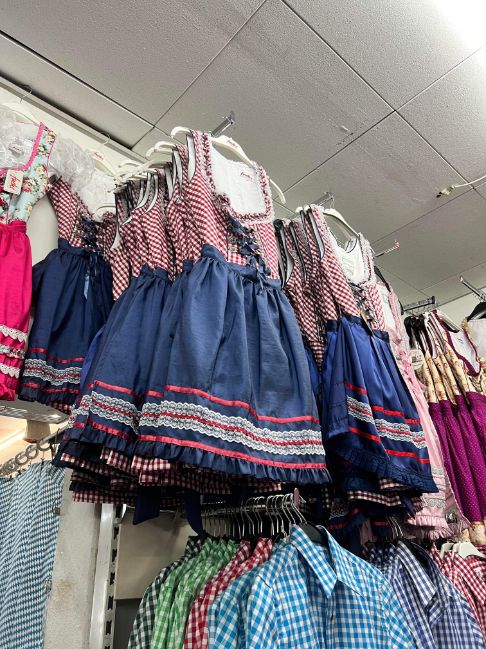
Do you have to wear lederhosen to go to Oktoberfest?
You most certainly do not have to go and buy a dirndl or lederhose in order to enjoy Oktoberfest. Heaps of guests go in regular street clothes with no attempt at dressing up and they stroll right into the tents like everyone else.
There’s no requirement to wear “Tracht” in order to attend, it’s just fun to get dressed up for the event.
I would say that it’s pretty easy for guys to wear a checked shirt in “Bavarian” style and some chino shorts and blend right in, in terms of regular clothes.
That said, you can absolutely attend in jeans and a jumper and laugh at everyone shivering their butts off when they’re leaving at 1am and its freezing cold outside.
You can also rent a suitable outfit for the event, there are a few different rentals around Munich who have rentals for different time periods and in all different styles, see above for one suggestion.
You may find, especially if you’re attending Oktoberfest in its final few days, that there will heavy discounts on outfits for sale and its actually cheaper to buy an outfit than it is to rent one.
But then of course, you don’t need to allocate any precious luggage space to an outfit that you might not wear again if you go with a rental.
What should you bring to Oktoberfest?
It’s a good idea to just bring the bare minimum with you to the festival.
Big bags aren’t permitted at Oktoberfest, the max allowable bag size is 5 litres (which is about a satchel worth of room) so pack light!
The best things to bring aside from the essentials like your phone, cards and cash – the beer tents do NOT accept card so bring cash – are a powerbank to charge your phone, photo ID, your room key and probably hand sanitiser for when you get beer spilt all over you, consider it a rite of passage at Oktoberfest.
If you happen to lose something, or wake up on the infamous “Vomit Hill” without your belongings, there is a large lost and found department over near the first aid tent so head there first.
Don’t forget to bring a jacket with you for the end of the night after you’ve had a great time enjoying the festivities of the beer tents.
In recent years, the weather for the Wiesn has been fairly mild but temperatures can drop steeply as the sun goes down.
At the end of the daytime temperatures reaching a mild 22 degrees Celsius, it can drop to single digits when you’re trying to make your way home at midnight.
Plan ahead and bring something to throw on along with your beer blanket for the chilly ride home.
Fun Fact: So many Australians lose their passport at Oktoberfest that the Australian Embassy in Munich just opens up a special spot there to help the inevitable drunk Aussies, nothing like being prepared.
Still got time to spend in the city? Check out this Munich 3 day itinerary for some ideas!
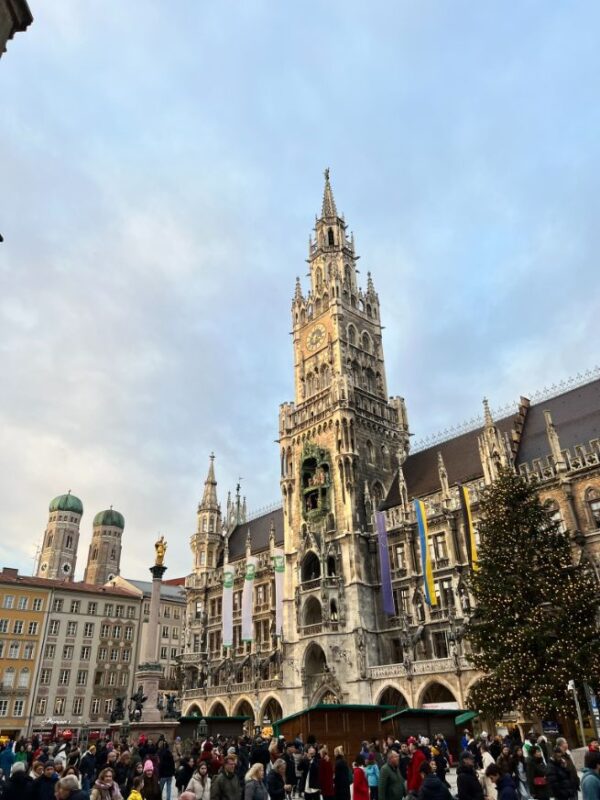
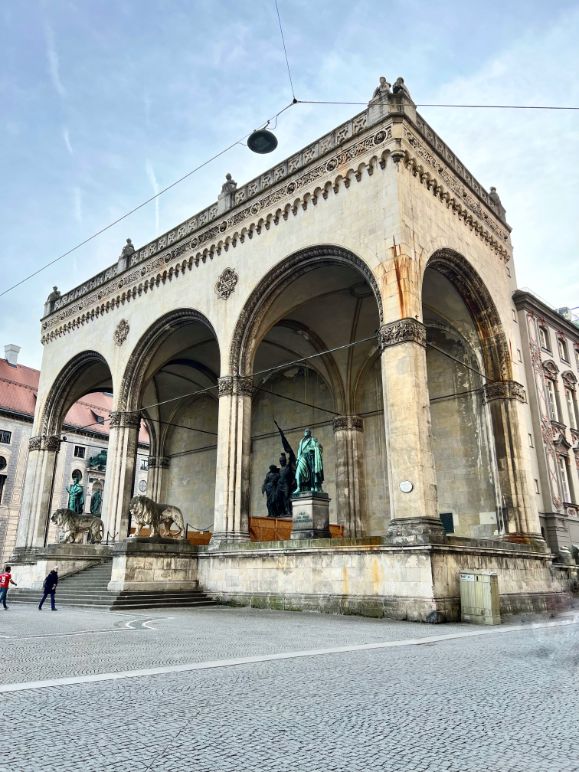
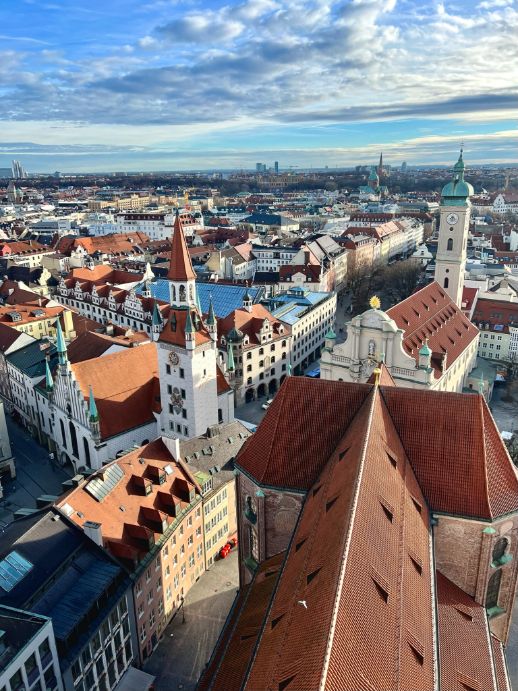
You’ve reached the end of this guide for what to wear to Oktoberfest Munich 2024
I hope I’ve managed to answer all of your questions about Bavarian traditional dress, what shoes to pair with a pretty dirndl and which socks go with lederhosen.
Oktoberfest is basically the best adults birthday party so why not dress up for the day and put on your best Bavarian beer song voice.
With your perfectly braided hair and beautiful dirndl, or handsome lederhose, you’ll be ready to party the day away in one of the beer tents or beer gardens. Making the most of Bavarian festivities!
Have you ever been to Oktoberfest before? Let me know in the comments below!
Wondering where to go next? The charming city of Nuremberg is just up the road
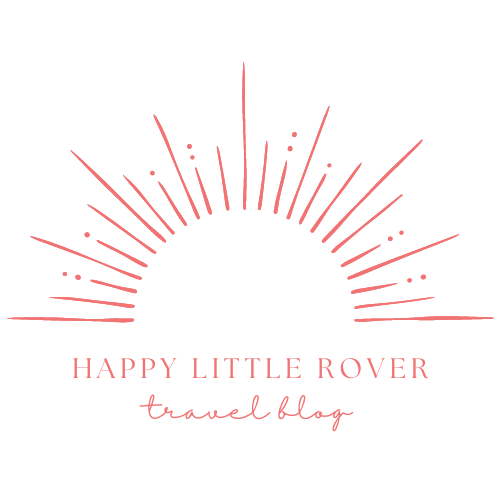
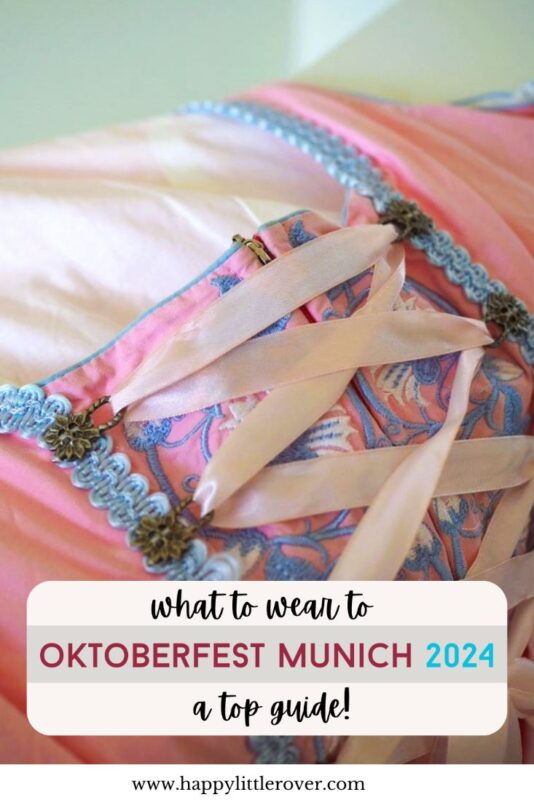
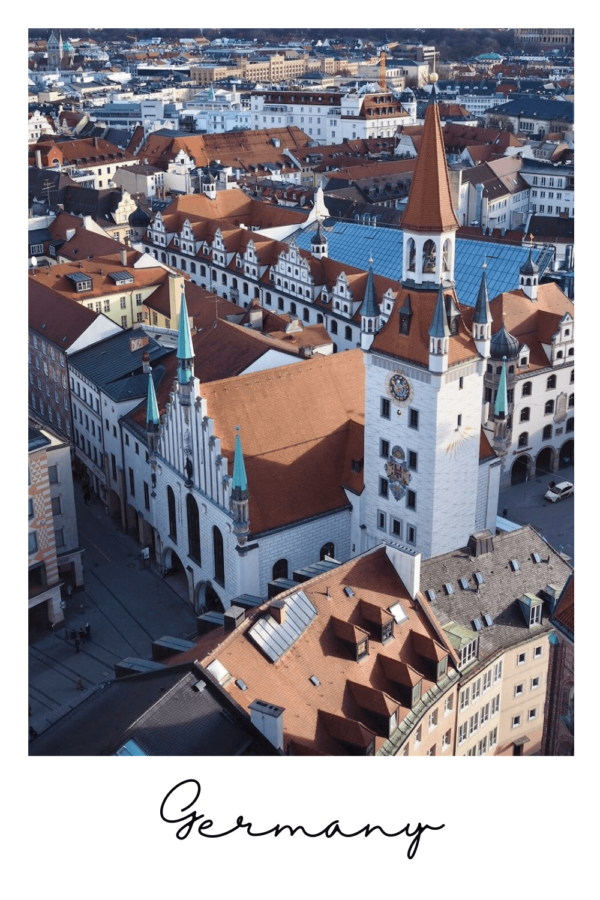
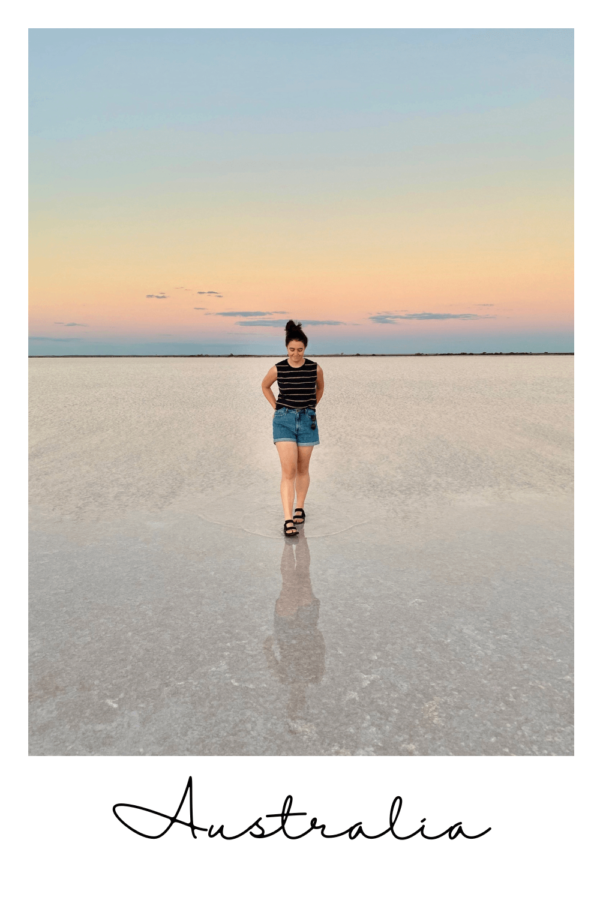
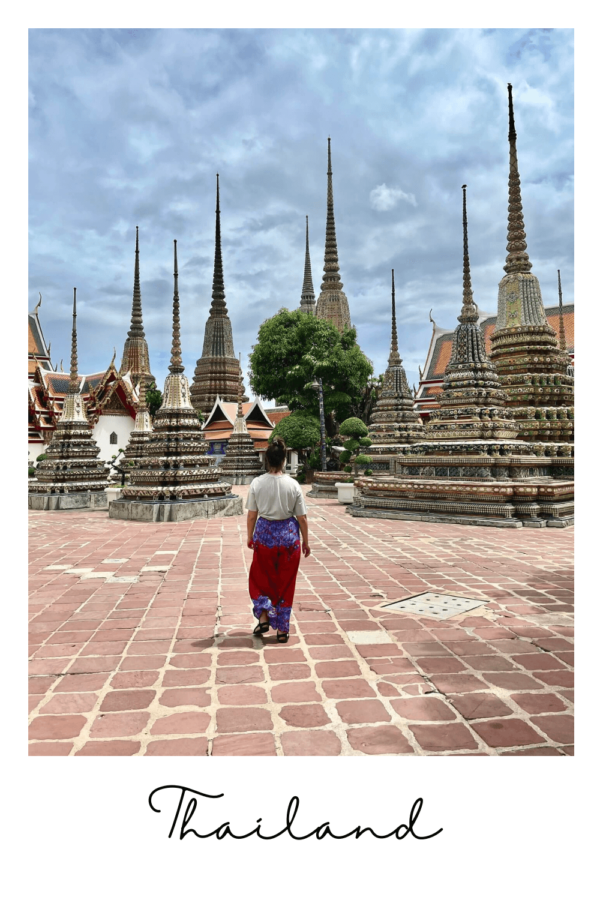



8 Comments
Join the discussion and tell us your opinion.
Fab post! The one you chose looks great on you. 🙂 I had no idea that the apron bow on a dirndl had meaning! That is such a cool nugget of culture! 🙂
Okay you weren’t lying, this actually IS the perfect guide!! Thank you for all the tips (especially when it comes to clothing)! I hope I can make it over there in 2024!
sounds like a fun experience! don’t think I would wear the clothes but otherwise definitely close toed shoes!
Your guide is so comprehensive. I love it especially when you tackle the meaning of the costume.
When I went to Oktoberfest we didn’t dress up – wish we did cause it adds to the atmosphere. Next time!
I’d much rather wear some traditional Bavarian clothing and join in with the spirit of Oktoberfest than wear some dodgy outfit. You’ve provided some really useful tips and tricks to fit in and have a great time. This is a great guide – thank you for sharing!
Love this detailed post on what to wear to Oktoberfest. Love the explanation of the dirndl bow.
Great post! Since a dirndl is part of Southern German and Austrian traditional dress, it pays to go to a proper traditional outfit shop in Munich to choose one and get good advice. A lot of the cheaper ones are polyester fast fashion made overseas and look and feel cheap. Every low rent online shop in Germany will also sell them seasonally. Going to a local shop and chose something well made at a fair wage, even if not a full dirndl, shows much more respect to this kind of traditional clothing. They are also pretty easy to sew, with loads of free resources online. For the men, it’s easier! Checked shirt seems prerequisite with an accessory or two. And definitely closed shoes, yes.